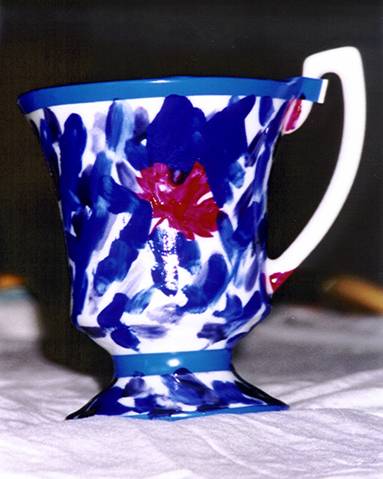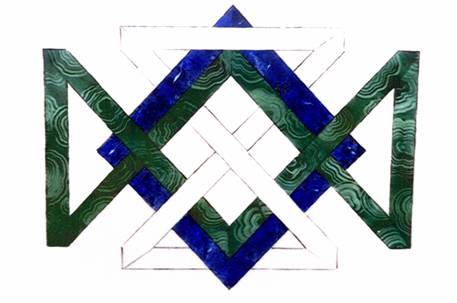
by Veronique Rigaud
You need :
- - medium
- - three different kinds of blue paint
- - ivory paint
- - bright gold (or lemon gold N° 56, Schjerning)
- - sponges (pink round ones and natural sponges with holes)
- - a wipe-out tool
 |
Lapis Lazuli by Veronique Rigaud You need :
|
 |
 |
| 1. Paint a thin layer of blue-colored patches over the whole surface: use mostly dark blue N° 13 Schjerning (or cornflower blue, or similar, but a bright blue), then blue Cobalt and some violet blue. Add some flux to your colors, but not more than one fourth of the paint. Soften the whole with a sponge. Take the natural sponge and apply it in several spots to take some paint off. You will then see white spots appear. If your natural sponge is dry and stiff, dip it in orange essential oil (or even plain water !) and wring it carefully. Using the same natural sponge, lightly add some Delft blue (N° 56) and even a little bit of black. If you have added too much color : soften. But do not forget that you can always make it darker afterwards so do not use the darkest paints in excess at this stage. Use the wipeout tool to obtain a veined effect. |
 |
As always with stone imitation, go ahead, dare, try : the only rule is
to like the final effect. You can always soften a vein which is too thick,
and a "mistake" often provides a good opportunity for doing something still
better, something you had not thought of at first! Take your time, play
with the paints. Enjoy it and it will work.
Now you can sprinkle your lemon gold over the paint using a small strainer. Sprinkle it very gently and irregularly but... not all over! Normally, the fake gold powder should just stick on the surface. If you do not have that lemon gold, just fire without and you'll add some bright gold at the second stage. Fire at 850°C (cone 15 or around 1550°F) 2. At this stage, you can choose to stop, or continue with the different colors mentioned above. You can also add ivory in the white spots and veins. Fire at 830°C (cone 16 or around 1520°F) |
 |
Possible problems: -Thickness : as always! Although it is less risky than with the malachite, be careful with it. - After firing, it happens that the lemon gold has disappeared from the paint (you cannot really see it). If your surface is large, use an old tooth-brush to spray some bright gold over certain places (just scratch the hair of the brush with your nail above your work!). If your surface is small, add some bright gold with the tip of a thin brush. If you have added bright gold : fire a third time at 760°C (cone 18 or around 1390°F)
|
| Tricks:
- If the surface covered with lapis-lazuli is very small, like for example in the marble-bouquet (the ribbon, some petals, etc...), you can replace the gold with a yellow-brown paint and use a natural sponge. - If you do not have a natural sponge : just use one you have in the house and cut holes in it with scissors. - Flux, added to your paints, will make it brighter.
Advice: Véronique |